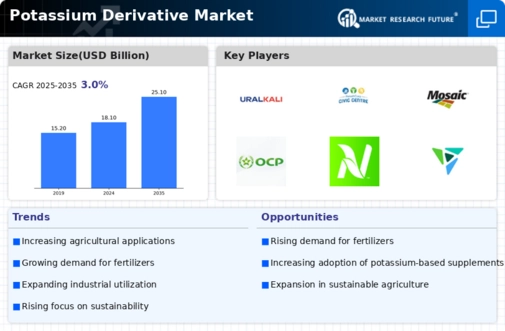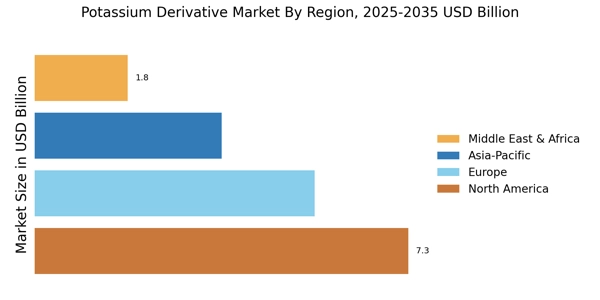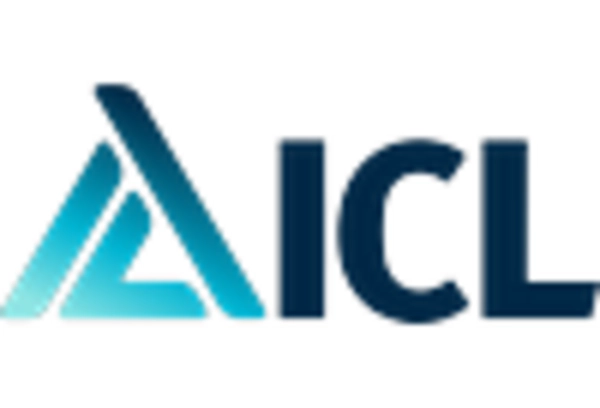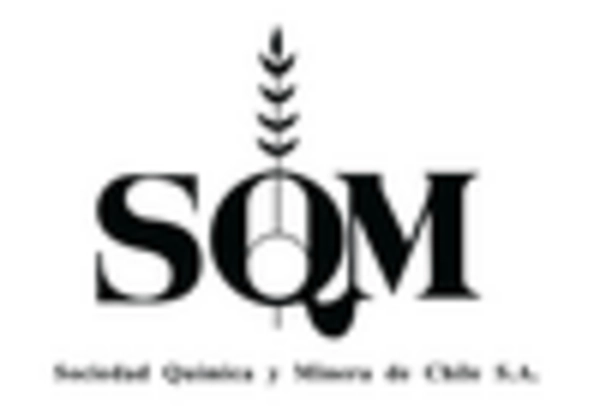Rising Demand for Fertilizers
The Potassium Derivative Market is experiencing a notable increase in demand for fertilizers, particularly potassium-based fertilizers. This trend is driven by the need to enhance agricultural productivity and ensure food security. As the global population continues to grow, the pressure on agricultural systems intensifies, leading to a projected increase in potassium fertilizer consumption. According to recent estimates, the potassium fertilizer market is expected to reach a value of approximately USD 30 billion by 2026. This surge in demand is likely to propel the Potassium Derivative Market, as farmers seek to optimize crop yields and improve soil health through the application of potassium derivatives.
Expansion of Industrial Applications
The Potassium Derivative Market is witnessing an expansion in industrial applications, which is contributing to its growth. Potassium derivatives are utilized in various industries, including pharmaceuticals, food processing, and chemical manufacturing. The increasing use of potassium compounds in the production of specialty chemicals and pharmaceuticals is particularly noteworthy. Market analysis suggests that the demand for potassium derivatives in industrial applications is expected to grow at a steady pace, driven by the need for high-quality raw materials. This expansion into diverse industrial sectors may provide a significant boost to the Potassium Derivative Market, as manufacturers explore new avenues for product development and innovation.
Advancements in Extraction Technologies
Technological advancements in the extraction and processing of potassium derivatives are significantly influencing the Potassium Derivative Market. Innovations such as selective mining techniques and improved processing methods are enhancing the efficiency of potassium extraction. These advancements not only reduce production costs but also minimize environmental impacts, aligning with the growing emphasis on sustainable practices. The introduction of more efficient extraction technologies could potentially increase the availability of potassium derivatives, thereby meeting the rising demand from various sectors, including agriculture and industrial applications. As a result, the Potassium Derivative Market is likely to witness a shift towards more sustainable and economically viable production methods.
Growing Awareness of Nutritional Benefits
The Potassium Derivative Market is benefiting from an increasing awareness of the nutritional benefits associated with potassium. As consumers become more health-conscious, the demand for potassium-rich products is on the rise. Potassium derivatives are recognized for their role in maintaining cardiovascular health, regulating blood pressure, and supporting overall well-being. This trend is reflected in the food and beverage sector, where potassium fortification is becoming more prevalent. Market data indicates that the potassium supplement segment is projected to grow at a CAGR of 5% over the next five years. This growing awareness is likely to drive the Potassium Derivative Market as manufacturers seek to capitalize on the health and nutrition focus.
Regulatory Support for Sustainable Agriculture
The Potassium Derivative Market is also influenced by regulatory frameworks that promote sustainable agricultural practices. Governments and international organizations are increasingly implementing policies that encourage the use of environmentally friendly fertilizers, including potassium derivatives. These regulations aim to reduce the environmental impact of conventional farming methods and promote soil health. As a result, the demand for potassium-based fertilizers is expected to rise, as farmers seek to comply with these regulations while enhancing crop productivity. The regulatory support for sustainable agriculture could potentially create new opportunities for growth within the Potassium Derivative Market, as stakeholders adapt to changing agricultural practices.


















Leave a Comment